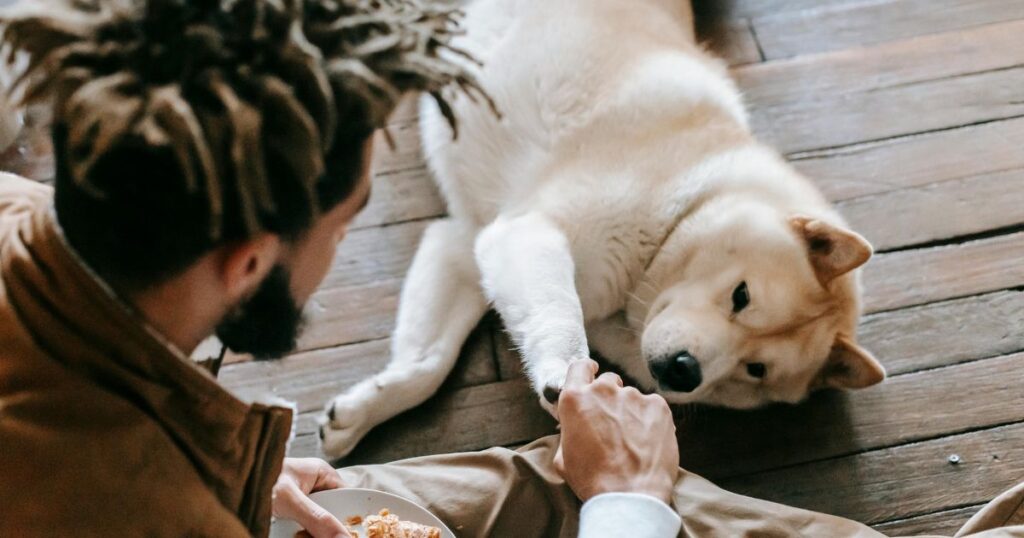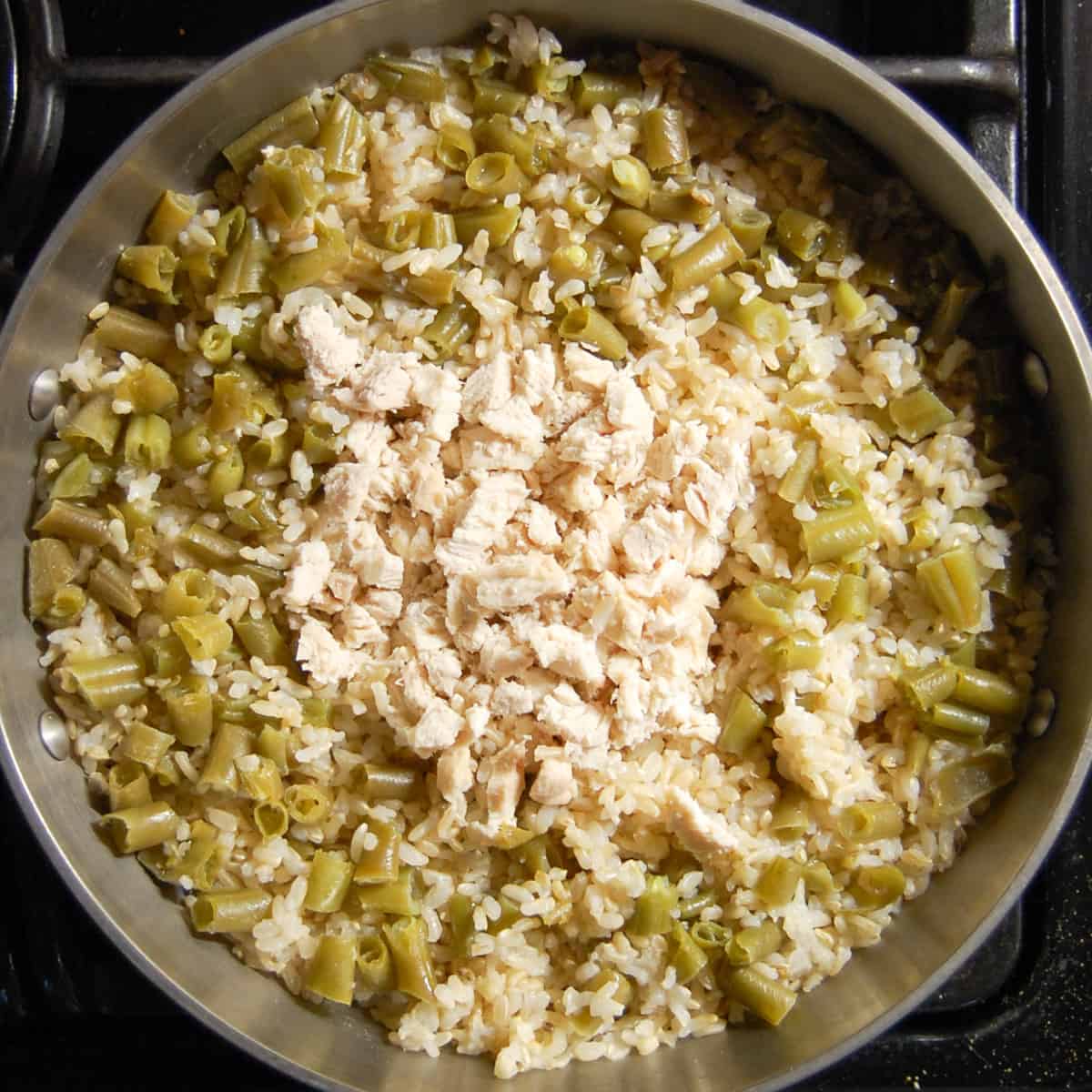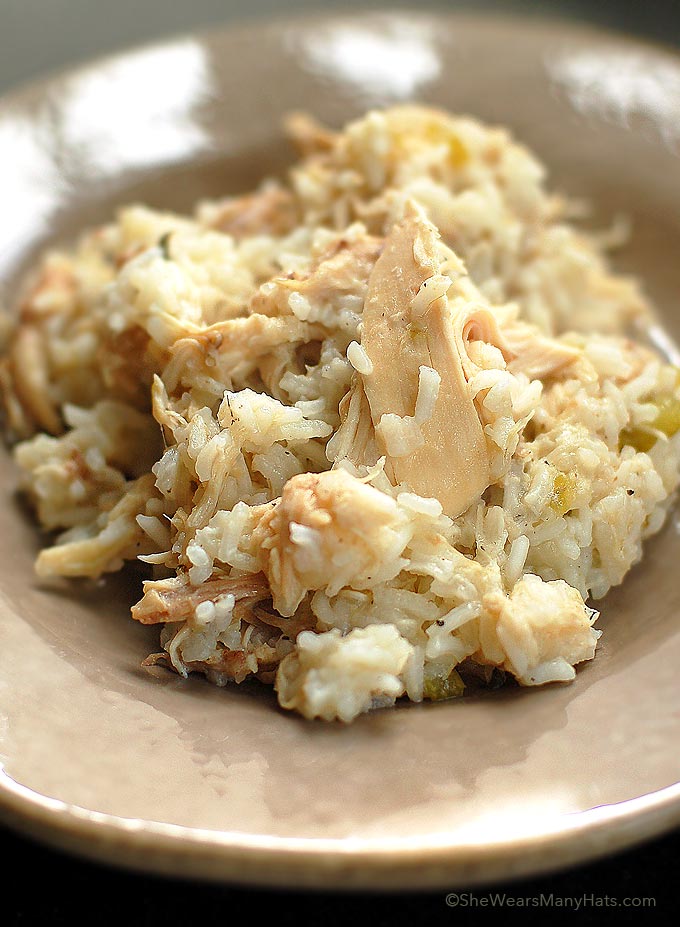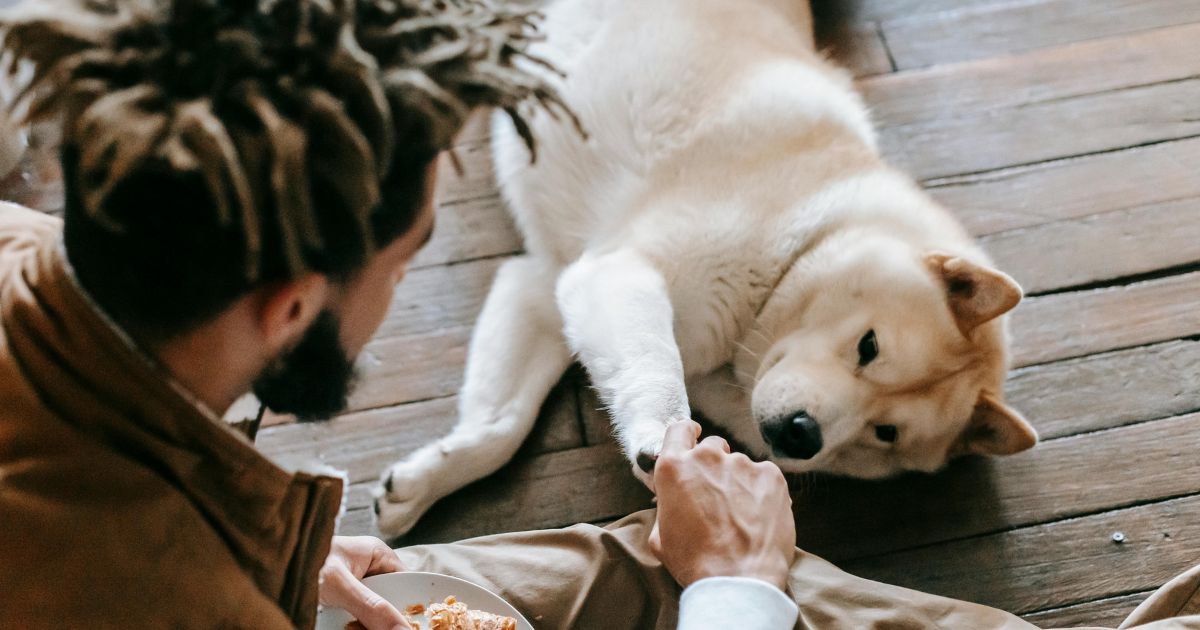As an Amazon Associate, I earn from qualifying purchases

Chicken And Rice to Feed Dog: Determining the right amount of chicken and rice to serve your canine companion is crucial for their health and well-being.
A balanced diet is essential, especially when dealing with dietary sensitivities or stomach upsets, which is often when a bland diet of chicken and rice is recommended.
Always consider your pet’s size, age, and activity level, as these factors influence their dietary needs. Consulting with a veterinarian can provide personalized guidance to ensure your dog receives the right nutrition.
Remember, the chicken should be cooked plainly without any harmful additives, and the rice should be white and well-cooked to promote easy digestion. Transitioning back to regular dog food should be gradual once your dog’s health stabilizes.
How much chicken and rice to feed the dog?
The amount of chicken and rice to feed your dog depends on their size and weight. A general guideline is to provide smaller dogs (up to 10 lbs) with ¼ to ½ cup per meal, medium-sized dogs (20-50 lbs) with 1 to 1 ½ cups, large dogs (50-100 lbs) with 2 to 3 cups, and giant dogs (over 100 lbs) with 3 to 4 cups.
It’s most important to prepare the meal by cooking plain, unseasoned chicken and rice in a 2:1 ratio—2 parts rice to 1 part chicken. This meal is typically used for dogs recovering from digestive issues, so always consult your vet for specific recommendations.
The Basics Of A Balanced Diet For Dogs
Nurturing your furry friend with a balanced diet is crucial. A balanced diet supports their health. It can help your dog live a longer and happier life. Let’s dive into what makes up this diet.
Essential Nutrients In Pet Foods
Dog foods should have several key nutrients. These include proteins, fats, carbohydrates, vitamins, and minerals. Each nutrient plays a role in your dog’s body.
- Proteins: They build and repair tissues.
- Fats: Fats give dogs energy and keep the skin and coat healthy.
- Carbohydrates: These nutrients give energy and help with digestion.
- Vitamins and Minerals: They support body functions and health.
Role Of Chicken And Rice
Chicken and rice are popular in dog diets. They are easy to digest. They provide great nutrition. Chicken is a good protein source. It builds strong muscles. Rice provides carbohydrates for energy.
| Ingredient | Nutrient | Benefits |
|---|---|---|
| Chicken | Protein | Builds muscles, repairs tissue |
| Rice | Carbohydrates | Provides energy, aids digestion |
When preparing meals, ensure proportions are correct. The right balance is key for your dog’s health. A vet can help you understand the perfect portion for your dog.

Benefits Of Chicken And Rice For Canines
Many dog owners seek healthy, homemade meal options for their furry friends. A classic choice is chicken and rice. This simple dish offers several benefits to canines.
Digestive Health Improvement
Chicken and rice are gentle on a dog’s stomach. They can help soothe digestive woes. For dogs with upset stomachs, this meal is an excellent choice.
- Easily digestible: Simple for dogs to break down and absorb nutrients.
- Settles stomachs: Helps dogs with diarrhea or vomiting feel better.
Lean Protein Source For Dogs
Chicken is a top-notch protein that supports muscle development. It’s low in fat too, making it a healthy option for dogs.
| Protein Benefits | Why It’s Good |
|---|---|
| Builds muscle: | Protein helps dogs grow and repair muscle. |
| Energy source: | Chicken provides energy for play and exercise. |
Picking the right amount of chicken and rice for your dog depends on size, age, and energy levels. Start with a small portion and adjust accordingly.
Determining The Right Amount For Your Dog
Finding the perfect portion of chicken and rice for your dog can be tricky. Dogs are like family, and we want to make sure they’re eating just right. Not all dogs are the same, and neither are their diets. Let’s figure out the best amount to keep your pup happy and healthy!
Factors Influencing Diet Portions
Several factors play a role in how much food your dog needs. These include size, weight, age, and health status. Mature dogs might need less food than fast-growing puppies. Dogs with health conditions might need a special diet plan. Always check with a vet to know what’s best for your furry friend.
Activity Level And Caloric Needs
Active dogs need more fuel to keep going. If your dog loves to run and play, they’ll burn more calories. They’ll need more chicken and rice to stay energized. Lazy dogs or those with a chill lifestyle won’t need as much. Think about your dog’s routine and match their meals to their movement!
| Weight of Dog | Inactive | Active |
|---|---|---|
| 5 lbs | 1/3 cup | 1/2 cup |
| 20 lbs | 1 cup | 1 and 1/2 cups |
| 50 lbs | 2 cups | 3 cups |
Remember to adjust meals for special cases. If it’s hot outside or your dog is feeling under the weather, they might eat differently. Puppies and older dogs have unique needs, so their chicken and rice portions will vary.
Keep an eye on how they act after eating. You can tell a lot about whether the amount was too little or too much. For personalized advice, your vet is always there to help!
Calculating Your Dog’s Daily Caloric Requirements
When planning your dog’s diet, it’s vital to know how much energy they need. Feeding the right amount of chicken and rice depends on their daily caloric requirements.
This varies based on age, weight, and activity level. Let’s break down the basics so you can ensure your furry friend gets just the right nourishment.
Using Formulas For Energy Needs
Experts use formulas to estimate a dog’s energy needs. The Resting Energy Requirement (RER) formula is a common starting point.
It’s based on your dog’s weight. To calculate RER, you multiply your dog’s weight in kilograms raised to the ¾ power by 70.
RER = 70 (Body Weight in kg)^0.75
For a dog weighing 15 kg, the RER would look like this:
RER = 70 (15)^0.75 = 70 (6.2) ≈ 434 calories/day
Remember, this is just the base. Active dogs need more calories.
Adapting To Life Stages
A dog’s life stage greatly influences their caloric needs. Puppies, for instance, require more energy for growth.
- Puppies may need twice the calories of adult dogs
- Adult dogs need a balanced diet to maintain weight
- Senior dogs often require fewer calories due to less activity
Adjust portions of chicken and rice based on these stages. Consult a vet for precise guidance tailored to your dog.
Chicken And Rice Serving Size Breakdown
Wondering about the perfect chicken and rice serving size for your furry friend? Finding the right balance ensures a healthy, happy pup.
Whether it’s a special diet or a treat, this Chicken and Rice Serving Size Breakdown simplifies meal prep. Read on to ensure your dog gets the right nutrients from this homemade staple.
Proportion Of Chicken To Rice
Getting the chicken to rice ratio correct is crucial for your dog’s diet. A general rule is a 2:1 ratio of rice to chicken. This means that for every one cup of cooked chicken, add two cups of cooked rice.
This blend offers sufficient protein and carbohydrates. Adjustments might be needed based on specific dietary needs. Consult with a vet for tailored advice.
Measuring Cups Vs. Weight
Measuring cups are convenient, but weighing food ensures precision. For consistency, use a kitchen scale when serving chicken and rice to your pet. Dry rice requires about 1/4 cup (45g) per 10 pounds of body weight.
For cooked chicken, 1/3 cup (approximately 40g) per 10 pounds is sufficient. Doing this helps maintain ideal portion size and avoids overfeeding.
| Dog’s Weight (lbs) | Cooked Chicken (cups) | Cooked Rice (cups) |
|---|---|---|
| 10 | 1/3 | 2/3 |
| 20 | 2/3 | 1 1/3 |
| 30 | 1 | 2 |
| 40 | 1 1/3 | 2 2/3 |
Remember, these measures serve as a guideline. Individual needs may vary. For specific feeding plans, especially for health concerns, seek expert guidance. Chicken and rice can be a healing meal for dogs with upset stomachs. Yet, it should not replace balanced, long-term nutrition. Always prioritize your pet’s overall dietary needs.
Recipes For Homemade Meals
Feeding your furry friend doesn’t have to be costly or time-consuming. Homemade meals ensure your dog gets a nutritious and well-balanced diet. Below are easy recipes for a simple yet delightful chicken and rice meal with variations.
Simple Chicken And Rice Recipe
Make mealtime enjoyable with this straightforward recipe. You’ll need:
- Boneless chicken breast or thighs
- White or brown rice
- Water for cooking
| Ingredient | Dog’s Weight (lbs) | Cups (Cooked) |
|---|---|---|
| Chicken | 10 | 1/4 |
| Rice | 10 | 1/3 |
| Chicken | 20 | 1/2 |
| Rice | 20 | 2/3 |
Cook the chicken thoroughly. Boil the rice until soft. Mix and serve cool.
Variations With Veggies And Supplements
Enhance the nutritional value with veggies and supplements. Here are some additions:
- Pumpkin: Aids in digestion.
- Carrots: Packed with vitamins.
- Green Beans: Low in calories and full of iron.
For the best results:
- Stick to safe, dog-friendly vegetables.
- Introduce new items slowly.
- Ask your vet about appropriate supplements.
Adjust the chicken-to-rice ratio depending on your dog’s size, activity level, and health needs. Your pup’s tail will be wagging in no time!
Precautions When Feeding Chicken And Rice
Chicken and rice is often a go-to meal for dogs needing a bland diet. Yet, it’s vital to proceed with caution. This simple dish can be beneficial, but there are risks to consider. Precautions ensure your pet stays healthy and happy while enjoying this classic canine dish.
Allergy Considerations
Not all dogs digest chicken and rice well. Some might be allergic to chicken. Keep an eye out for signs of an allergic reaction.
These can include itching, digestive upset, or respiratory issues. A vet visit is necessary if you notice any adverse effects.
Avoiding Nutritional Imbalances
Chicken and rice should not replace a regular diet long-term. It doesn’t contain all the nutrients dogs need. To avoid nutritional imbalances, follow these guidelines:
- Keep it short-term: Use this diet only for a few days.
- Balance is key: Reintroduce regular food gradually.
- Supplements: Consult a vet about adding vitamins or minerals.
- Proportion control: Feed appropriate amounts based on your dog’s size and caloric needs.
Remember, a healthy diet promotes a healthy dog. These precautions ensure your furry friend benefits from the chicken and rice meal without any drawbacks.

Transitioning Your Dog To A Chicken And Rice Diet
Is your pup under the weather? A chicken and rice diet might help. This simple food switch can soothe upset stomachs. Vets often recommend it. But changing your dog’s diet needs care. Let’s make this transition easy and safe for your furry friend.
Gradual Diet Changes
Introduce chicken and rice slowly. Start with a mix. Use 25% new food and 75% old food. Over the next 5-7 days, increase the chicken and rice. Decrease the standard food bit by bit.
- Day 1-2: Serve 75% old food, 25% chicken and rice.
- Day 3-4: Make it a 50/50 split.
- Day 5-6: Now 75% chicken and rice, 25% old food.
- Day 7: Go full chicken and rice.
Remember chicken should be boneless, skinless, and cooked. No spices or onion. Cook rice well. Brown rice has more nutrients but is harder to digest than white rice.
Monitoring Your Dog’s Reaction
Watch your dog closely. Look for signs of improvement or distress. Good signs include more energy and less stomach trouble. Bad signs are new or worsening symptoms.
Signs to watch:
- Less vomiting or diarrhea.
- Better appetite.
- More active and playful.
- No new signs of stomach pain or discomfort.
If you see bad signs or no change in 2 days, call the vet.
Weight, age, and health affect how much to feed. For every 20 pounds, 1 cup of rice and 1/3 pound of chicken is a common rule. Always check with your vet for the right amount.
Sticking to this plan ensures your dog gets the benefits of chicken and rice without any trouble. A calm switch means a happier, healthier pup!
Consultation With Veterinary Nutritionists
Feeding your furry companion the right amount of chicken and rice can sometimes feel like a guessing game. That’s where veterinary nutritionists step in. They bring expertise to your dog’s diet, ensuring your pup gets the perfect balance of nutrition.
Professional Dietary Advice
Seeking professional dietary advice for your dog has many benefits:
- Customized meal plans tailored to your dog’s specific needs
- Adjustments based on age, breed, weight, and health conditions
- Expert analysis on the role of chicken and rice in your dog’s diet
- Guidance on preparation methods and portion sizes
When To Seek A Specialist’s Help
Knowing the right time to consult a specialist can be crucial for your dog’s health. Here’s when you should consider it:
- If your dog shows signs of food sensitivities or allergies
- When facing digestive issues like chronic diarrhea or vomiting
- If your dog has special dietary needs due to medical conditions
- When you’re considering a major diet change for your dog
Professional guidance ensures your dog remains happy, healthy, and well-fed with the right chicken and rice servings.

Conclusion
To sum up, providing the appropriate quantity of chicken and rice to your dog is important for recovery from illness as well as maintaining proper nutrition. Portions need, however, to be based on the size of your dog where a small quantity is about ¼-1/2 cup for smaller dogs and up to 4 cups for larger ones.
Ensure there is always twice more rice than chicken cooked plain, with no seasoning. Although this diet helps manage short-term digestive issues, transition your dog back to a complete and balanced diet under veterinary guidance to avoid long-term nutritional imbalances.
As an Amazon Associate, I earn from qualifying purchases

